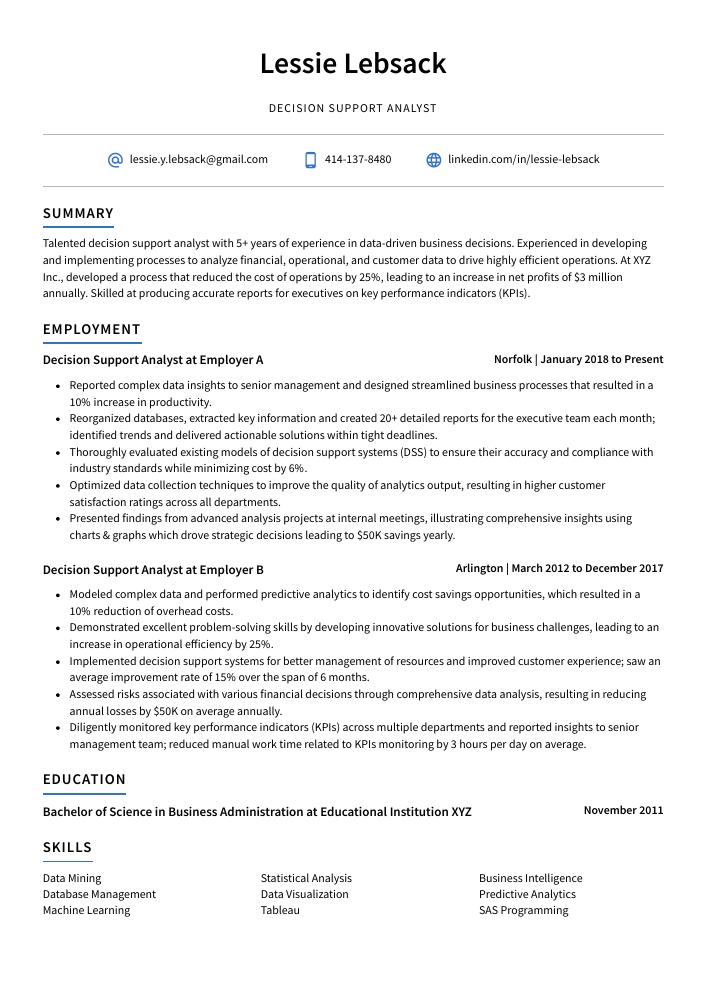Decision Support Analyst Resume Guide
Decision Support Analysts work with organizations to develop and analyze data, then use that information to help their clients make informed decisions. They create reports from the collected data, identify trends in the market, provide forecasts and simulations for various scenarios, and assist in developing plans based on current conditions.
You have the perfect combination of analytical and problem-solving skills to make you an ideal decision support analyst. But employers don’t know that yet, so make sure your resume is up to date and stands out from the crowd in order for them to take notice.
This guide will walk you through the entire process of creating a top-notch resume. We first show you a complete example and then break down what each resume section should look like.
Table of Contents
The guide is divided into sections for your convenience. You can read it from beginning to end or use the table of contents below to jump to a specific part.
Decision Support Analyst Resume Sample
Lessie Lebsack
Decision Support Analyst
lessie.y.lebsack@gmail.com
414-137-8480
linkedin.com/in/lessie-lebsack
Summary
Talented decision support analyst with 5+ years of experience in data-driven business decisions. Experienced in developing and implementing processes to analyze financial, operational, and customer data to drive highly efficient operations. At XYZ Inc., developed a process that reduced the cost of operations by 25%, leading to an increase in net profits of $3 million annually. Skilled at producing accurate reports for executives on key performance indicators (KPIs).
Experience
Decision Support Analyst, Employer A
Norfolk, Jan 2018 – Present
- Reported complex data insights to senior management and designed streamlined business processes that resulted in a 10% increase in productivity.
- Reorganized databases, extracted key information and created 20+ detailed reports for the executive team each month; identified trends and delivered actionable solutions within tight deadlines.
- Thoroughly evaluated existing models of decision support systems (DSS) to ensure their accuracy and compliance with industry standards while minimizing cost by 6%.
- Optimized data collection techniques to improve the quality of analytics output, resulting in higher customer satisfaction ratings across all departments.
- Presented findings from advanced analysis projects at internal meetings, illustrating comprehensive insights using charts & graphs which drove strategic decisions leading to $50K savings yearly.
Decision Support Analyst, Employer B
Arlington, Mar 2012 – Dec 2017
- Modeled complex data and performed predictive analytics to identify cost savings opportunities, which resulted in a 10% reduction of overhead costs.
- Demonstrated excellent problem-solving skills by developing innovative solutions for business challenges, leading to an increase in operational efficiency by 25%.
- Implemented decision support systems for better management of resources and improved customer experience; saw an average improvement rate of 15% over the span of 6 months.
- Assessed risks associated with various financial decisions through comprehensive data analysis, resulting in reducing annual losses by $50K on average annually.
- Diligently monitored key performance indicators (KPIs) across multiple departments and reported insights to senior management team; reduced manual work time related to KPIs monitoring by 3 hours per day on average.
Skills
- Data Mining
- Statistical Analysis
- Business Intelligence
- Database Management
- Data Visualization
- Predictive Analytics
- Machine Learning
- Tableau
- SAS Programming
Education
Bachelor of Science in Business Administration
Educational Institution XYZ
Nov 2011
Certifications
Certified Decision Support Analyst
International Institute for Decision Support Analysis
May 2017
1. Summary / Objective
Your resume summary should be a concise and compelling overview of your experience as a decision support analyst. Include the most relevant skills you possess, such as data analysis, predictive modeling, problem-solving abilities, and technical proficiency with various software programs. You should also mention any certifications or awards that demonstrate your expertise in this field. Finally, don’t forget to include how you have used these skills to improve processes for past employers.
Below are some resume summary examples:
Professional decision support analyst with experience in financial analysis, data gathering and reporting. Adept at providing strategic insights to inform management decisions while maintaining the highest level of accuracy. Successfully built an extensive database system for ABC Corporation that streamlined workflow processes by 20%. Proven ability to develop effective strategies and improve operational efficiency through analytics-driven decision making.
Well-rounded Decision Support Analyst with 8+ years of experience providing data-based reports, insights, and solutions to companies in the financial services sector. At XYZ Financial Services, delivered an average of 5 accurate decision support analysis models per month that resulted in a 10% increase in earnings for clients. Looking to join ABC Company and use my expertise to deliver actionable recommendations for complex business decisions.
Seasoned decision support analyst specializing in data mining, predictive analytics and market research. Experienced with a broad range of statistical software packages to identify trends and develop actionable insights from large datasets. At XYZ, developed recommendations for product launches resulting in increased revenue by 20%. Skilled at communicating complex quantitative analysis into meaningful business decisions for stakeholders.
Proficient decision support analyst with 6+ years of experience in data analysis, business intelligence, and financial modeling. Eager to join ABC Tech as an integral part of the team responsible for providing decision-making insights through effective collection and utilization of data from internal sources. At XYZ Inc., created models that were used to identify opportunities for cost savings leading to a 15% reduction in overhead costs.
Dependable decision support analyst with 8+ years of experience in data analysis, reporting and visualization. Skilled at creating actionable insights from large datasets to help management make informed decisions. At XYZ Inc., created a system for automated report generation that saved the company $25K annually and improved accuracy by 30%. Recognized as an excellent problem-solver who delivers high-quality results on time.
Amicable decision support analyst with extensive experience in data analytics and business intelligence. Highly proficient at creating complex financial models to improve decision-making processes, reduce costs, and increase revenue. At XYZ Corporation, led the development of a predictive model that forecasted sales growth by 50%. Adept at developing visuals for boardroom presentations to communicate findings effectively.
Driven decision support analyst with 5+ years of experience leading data-driven initiatives in the financial services industry. Skilled at collecting, analyzing, and interpreting complex business data to develop actionable insights that drive strategic decision making. Seeking to apply analytical expertise to ABC’s corporate strategy team for maximum impact on organizational performance.
Determined Decision Support Analyst with a proven track record of using data-driven insights to make sound business decisions. 5+ years of experience providing actionable intelligence and analytical support on projects that impacted the bottom line. At XYZ, developed a predictive analytics model which led to an 18% increase in profits for the organization.
2. Experience / Employment
The employment (or experience) section is where you talk about your work history. List this section in reverse chronological order, with the most recent job listed first.
When writing out what you did at each job, use bullet points for clarity and to make it easier for the reader to take in all of the information quickly. You want to provide detail when describing what you did and any results that were achieved due to your efforts.
For example, instead of saying “Analyzed data,” you could say, “Performed statistical analysis on large datasets using Python programming language; identified trends which led to a 10% increase in efficiency.”
To write effective bullet points, begin with a strong verb or adverb. Industry specific verbs to use are:
- Analyzed
- Evaluated
- Forecasted
- Modeled
- Optimized
- Interpreted
- Researched
- Developed
- Assessed
- Implemented
- Monitored
- Reported
- Summarized
- Visualized
- Collaborated
Other general verbs you can use are:
- Achieved
- Advised
- Compiled
- Coordinated
- Demonstrated
- Expedited
- Facilitated
- Formulated
- Improved
- Introduced
- Mentored
- Participated
- Prepared
- Presented
- Reduced
- Reorganized
- Represented
- Revised
- Spearheaded
- Streamlined
- Structured
- Utilized
Below are some example bullet points:
- Resourcefully synthesized and assessed large amounts of data to identify areas for improvement, resulting in an 18% increase in operational efficiency.
- Interpreted complex market trends and customer feedback to make informed decisions; successfully implemented 3 new strategies that increased revenue by $1 million within a year.
- Achieved cost savings goals by actively managing over 60 vendors while ensuring compliance with all regulations related to procurement procedures.
- Forecasted future budget requirements based on current financial results, enabling the business unit to stay ahead of any potential issues or challenges before they occurred; improved accuracy rate from 75% up to 95%.
- Evaluated existing decision-making processes against industry benchmarks, identifying 5 key opportunities for process improvements which resulted in a 15% reduction in costs associated with decision support activities.
- Streamlined the decision-making process across multiple departments, resulting in a 25% reduction of paperwork and administrative costs.
- Participated in data analysis projects to identify trends, uncover customer insights and optimize marketing strategies; increased sales by $50K within the first 6 months on the job.
- Facilitated meetings with stakeholders to discuss project requirements, develop solutions for business problems and implement action plans that met organizational objectives on time and under budget constraints.
- Analyzed large volumes of structured/unstructured data using advanced analytics techniques such as regression models, neural networks & machine learning algorithms; identified patterns or anomalies with 95% accuracy rate per task assigned.
- Accurately interpreted findings into reports presented to top management along with recommendations based on market research results which had positive effects on overall operational efficiency levels (+15%).
- Coordinated with Senior Management to develop and implement decision support systems for data-driven organization of business processes; improved efficiency by 40% and saved over $10,000 in operational costs.
- Spearheaded the design and implementation of a new analysis platform, leveraging complex algorithms to collect large amounts of data from disparate sources and delivering actionable insights within 24 hours or less.
- Proficiently created detailed reports using various software tools such as Microsoft Excel & SQL Server, allowing stakeholders to make informed decisions based on trends & forecasts identified through big data analytics techniques.
- Compiled weekly performance metrics which were used to evaluate organizational progress relative to established targets; achieved 99% accuracy rate with minimal errors across all projects monitored this quarter alone.
- Developed innovative strategies that integrated customer feedback into existing operations in order maximize ROI potentials; increased customer satisfaction rating by 30%.
- Successfully developed and implemented a business intelligence system to support decision making that increased accuracy of financial estimates by 15%.
- Monitored, evaluated and reported on data trends from multiple sources; identified key insights for management team in order to drive better decisions across the organization.
- Mentored junior analysts in analyzing company’s performance metrics and delivering actionable recommendations for strategic planning initiatives.
- Utilized advanced statistical techniques like regression analysis, predictive modeling & forecasting to provide high-level market insight & advice on customer segmentation strategies resulting in 20% growth year over year in sales revenue within 6 months of implementation.
- Introduced an automated dashboard tool with comprehensive visualization capabilities which enabled faster understanding of large datasets leading to 10% reduction in operational costs within 3 months time frame.
- Prepared and presented reports to senior management on weekly basis, outlining data-driven insights and concisely summarizing key decisions; generated a total of $50,000 in cost savings within the first year.
- Expedited the decision making process by structuring complex datasets into easily digestible formats for easy visualization and analysis; improved accuracy of predictions by 18%.
- Summarized findings from large volumes of customer feedback surveys into succinct executive summaries with impactful recommendations that helped increase customer satisfaction rate by 23%.
- Structured qualitative research data gathered through interviews and focus groups into quantitative models which enabled more reliable forecasting for future market trends up to 3 months ahead.
- Confidently identified potential patterns or anomalies among vast amounts of information sources to provide valuable decision support advice that led to successful outcomes in strategic initiatives 5 times out of 6 attempts.
- Researched customer needs and trends to develop sophisticated data-driven decision support models, resulting in a 15% increase of sales revenue over the past year.
- Independently created dynamic dashboards with visuals for stakeholders to track company performance metrics, enabling more informed decisions to be made quickly and efficiently.
- Reduced operational costs by 20%, through producing automated financial projections that accurately predicted cost efficiencies based on internal analysis of business operations data sets.
- Revised existing systems architecture design specifications according to client requirements while ensuring security compliance standards were met; successfully completed 40+ projects within tight deadlines over the last 3 years.
- Collaborated closely with software engineers, product managers & customers throughout development lifecycle stages; provided consultation services that boosted customer satisfaction ratings by 30%.
- Formulated complex decision support models and algorithms to evaluate business data, which resulted in a 10% increase in operational efficiency.
- Advised senior management on optimal data-driven decisions based on the analysis of financial trends, market forecasts and customer profiles; generated an additional $500K+ revenue for the company last year.
- Substantially improved the accuracy of predictive analytics by developing new machine learning techniques that reduced errors by 15%.
- Represented team at internal meetings with stakeholders from various departments to discuss project progress, identify areas needing improvement or optimization and ensure compliance with industry standards related to decision support systems/analytics processes.
- Visualized complex datasets using interactive dashboards & charts for easy tracking/comparison of insights gained from different analytical sources; saved over 200 hours in report-generation time annually compared to manual methods previously used.
3. Skills
Skill requirements will differ from one employer to the next; this can easily be ascertained from the job posting. Organization A may require a decision support analyst to be proficient in SAS, while Organization B may require expertise in Tableau.
It is important to tailor the skills section of your resume for each job you are applying for; this will ensure that applicant tracking systems (computer programs used by many employers nowadays) recognize it as a high-quality match. You can further elaborate on these skillset by discussing them more in other areas such as the summary or experience sections.
In addition, include any certifications and/or qualifications relevant to the role – they could give you an edge over other candidates!
Below is a list of common skills & terms:
- Business Intelligence
- Data Mining
- Data Visualization
- Database Management
- Machine Learning
- Predictive Analytics
- SAS Programming
- Statistical Analysis
- Tableau
4. Education
Mentioning an education section on a decision support analyst resume will depend on how far along you are in your career. If you have recently graduated and lack experience, mentioning your education below the resume objective is recommended. However, if you already have plenty of work experience to showcase, omitting an education section altogether might be better for highlighting other relevant skills and accomplishments.
If including an education section is necessary, try to mention courses or subjects related to the role of decision support analyst that are applicable to the job position.
Bachelor of Science in Business Administration
Educational Institution XYZ
Nov 2011
5. Certifications
Certifications demonstrate to employers that you have the necessary knowledge and skills for a given job. They also show your commitment to professional development, as well as your dedication to staying up-to-date with industry trends.
If you are applying for a position where certifications are required or preferred, make sure that these credentials appear prominently on your resume. This will help demonstrate why you would be an ideal candidate for the role.
Certified Decision Support Analyst
International Institute for Decision Support Analysis
May 2017
6. Contact Info
Your name should be the first thing a reader sees when viewing your resume, so ensure its positioning is prominent. Your phone number should be written in the most commonly used format in your country/city/state, and your email address should be professional.
You can also choose to include a link to your LinkedIn profile, personal website, or other online platforms relevant to your industry.
Finally, name your resume file appropriately to help hiring managers; for Lessie Lebsack, this would be Lessie-Lebsack-resume.pdf or Lessie-Lebsack-resume.docx.
7. Cover Letter
Including a cover letter with your resume is a great way to make a good first impression with potential employers. It should contain 2-4 paragraphs and provide an opportunity for you to detail why you are the perfect fit for the role.
Cover letters offer recruiters more insights than what can be found in your resume alone, such as personal experiences or traits that could not otherwise be seen from just looking at your CV. Although cover letters aren’t always mandatory, writing one is highly recommended as it gives you a chance to stand out from other applicants who may have similar qualifications and experience.
Below is an example cover letter:
Dear Tomasa,
I am interested in the Decision Support Analyst position at XYZ Corporation. With my experience in data analysis, report writing, and presenting findings to stakeholders, I feel confident I would be a valuable asset to your team.
In my current role as a Data Analyst for ABC Corporation, I regularly collect and interpret data to support decision making for upper management. I have also created numerous reports and presentations on my findings that have been well received by company leadership. My ability to take complex data sets and distill them into easily digestible information has been praised by my supervisors.
I am also familiar with various business intelligence tools such as Tableau and Microsoft Power BI. I am confident I could put these skills to use in developing insightful reports that would help your organization make sound decisions.
Lastly, I have excellent communication skills that would enable me to effectively present my findings to stakeholders at all levels of the organization. My goal is always to provide actionable insights that can improve organizational performance.
Please find attached a copy of my resume for your review. If you have any questions or would like to discuss the role further, please do not hesitate to contact me at [phone number] or [email address]. Thank you for your time and consideration; I look forward hearing from you soon!
Sincerely,
Lessie
Decision Support Analyst Resume Templates
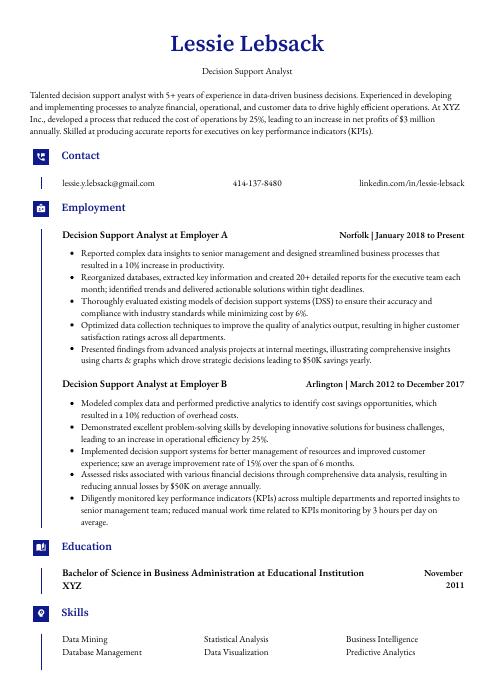 Gharial
Gharial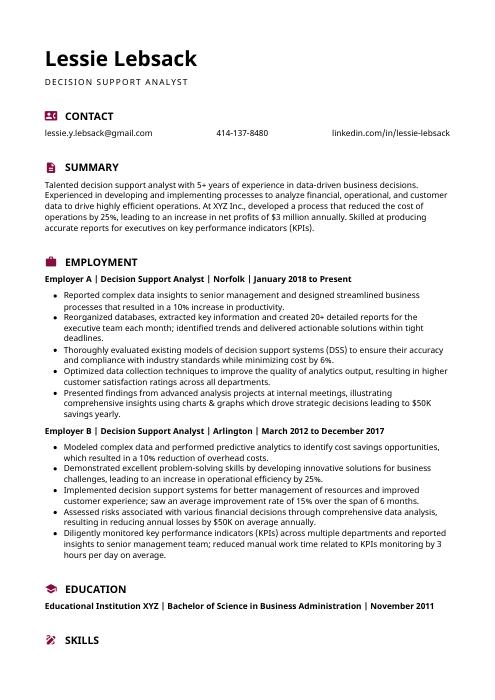 Hoopoe
Hoopoe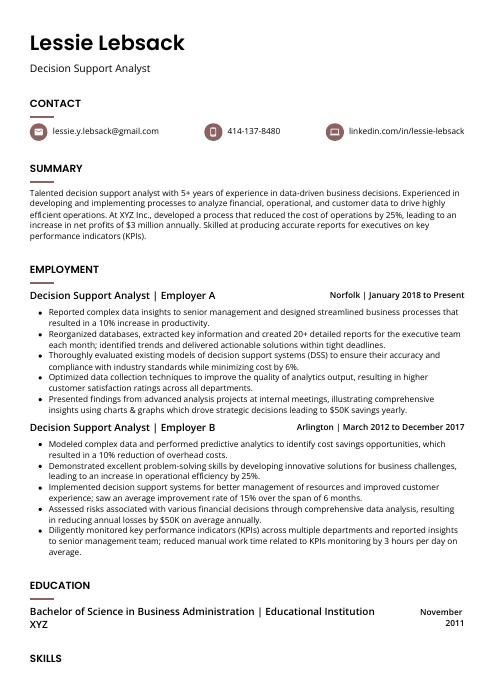 Fossa
Fossa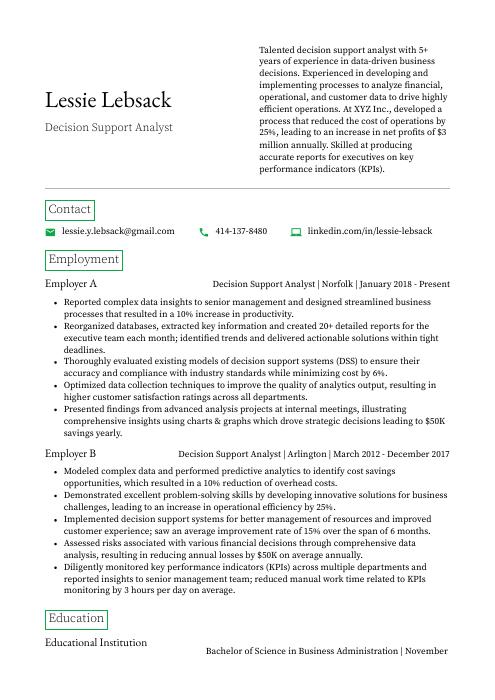 Quokka
Quokka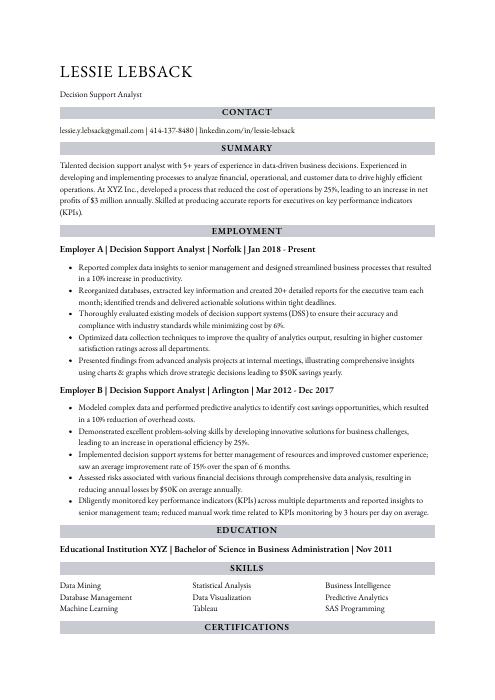 Numbat
Numbat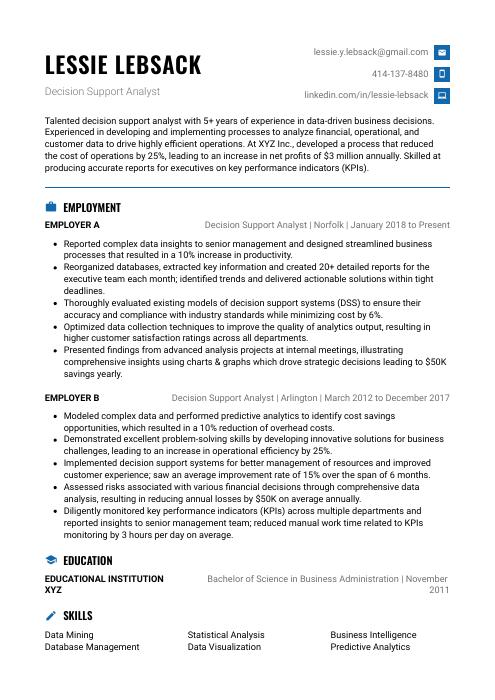 Echidna
Echidna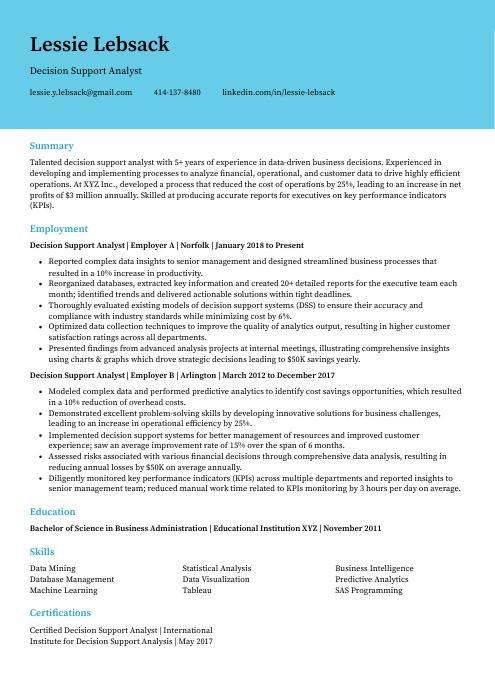 Dugong
Dugong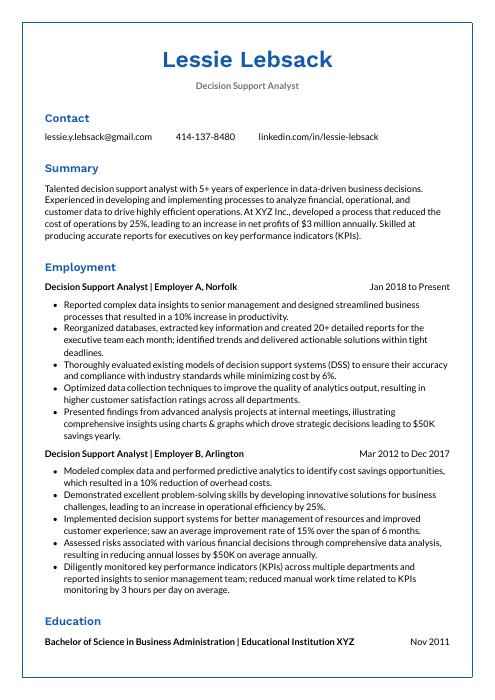 Markhor
Markhor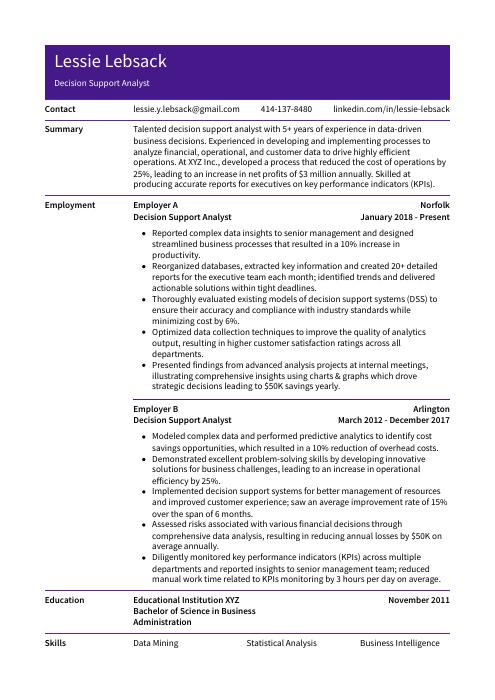 Pika
Pika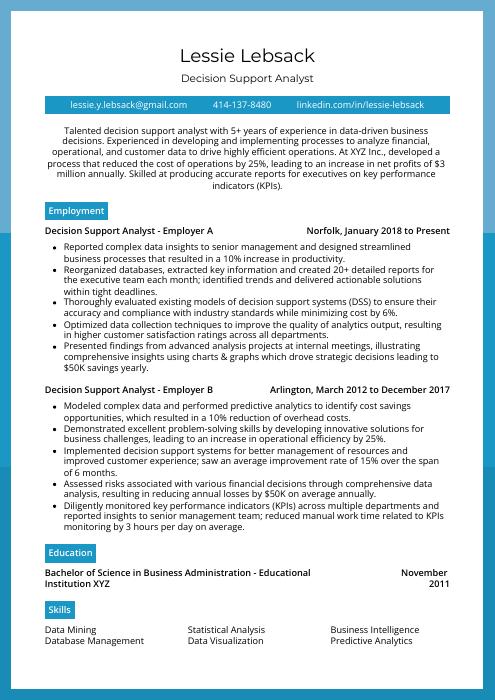 Rhea
Rhea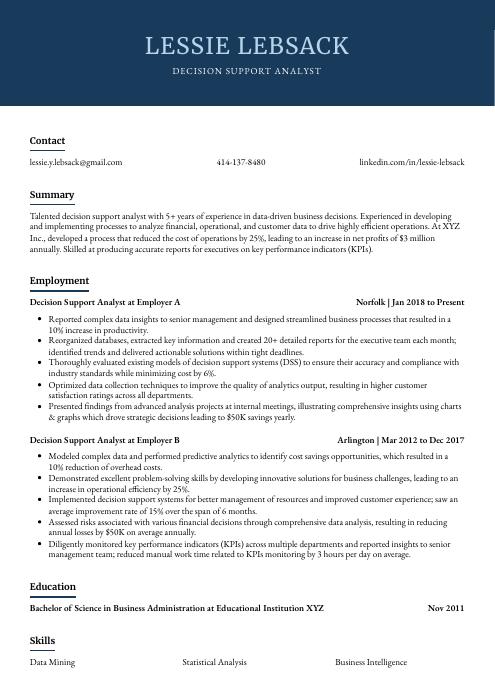 Bonobo
Bonobo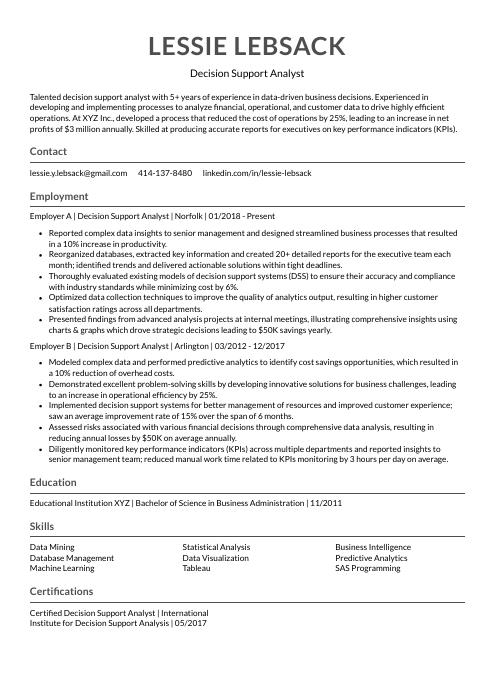 Indri
Indri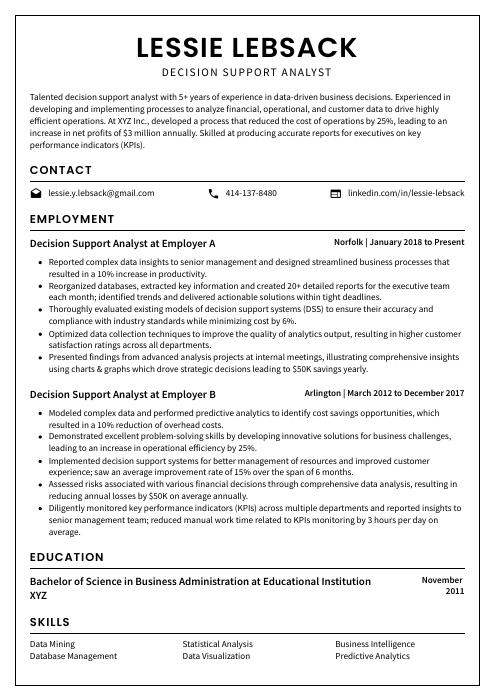 Cormorant
Cormorant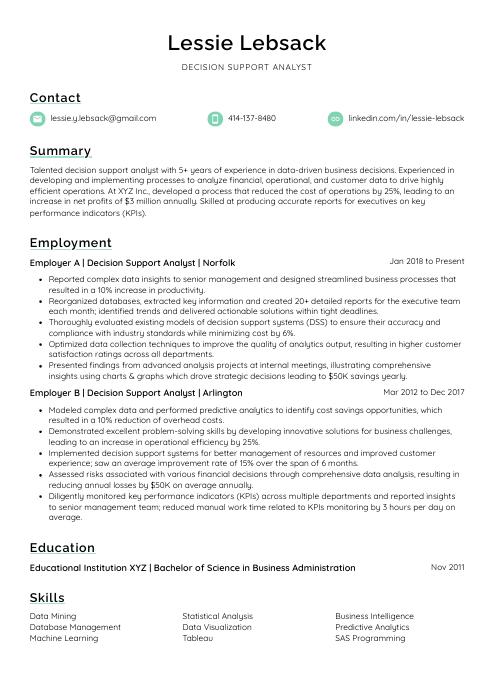 Lorikeet
Lorikeet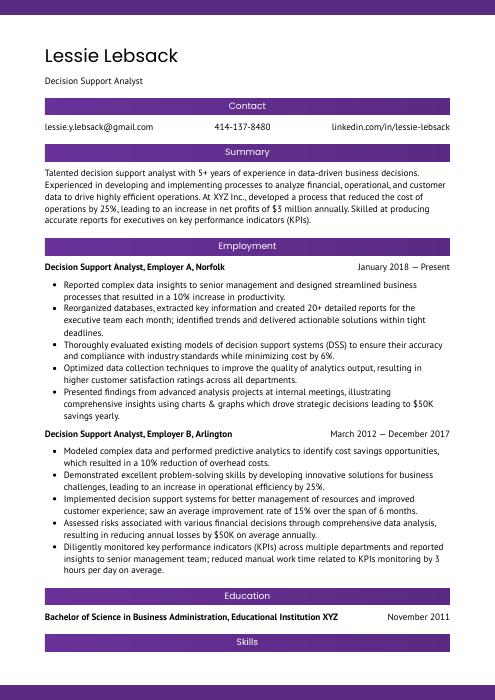 Jerboa
Jerboa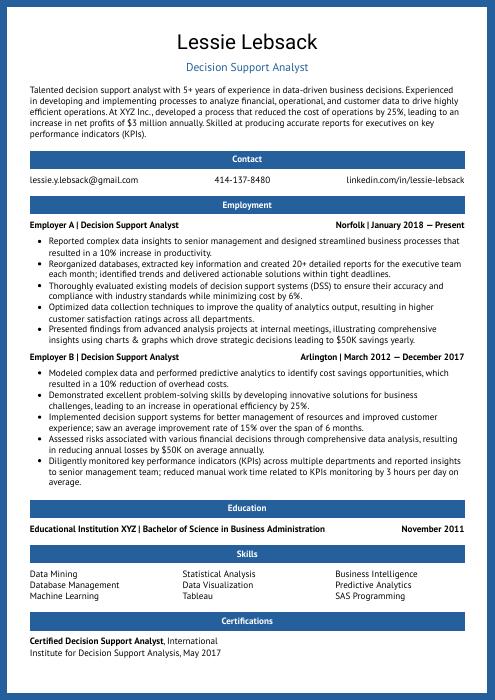 Ocelot
Ocelot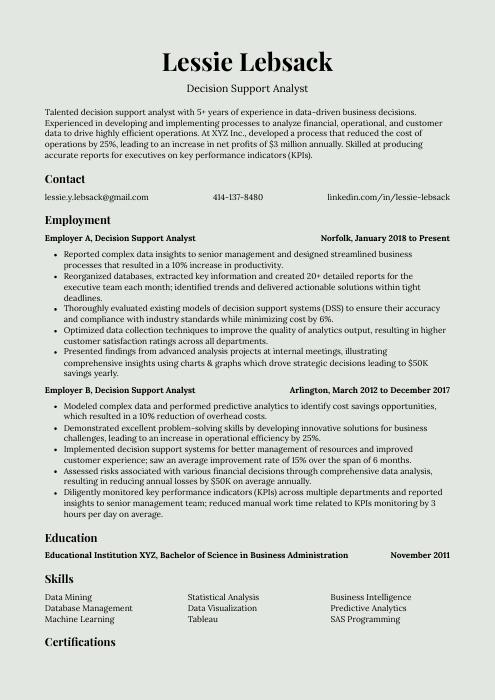 Saola
Saola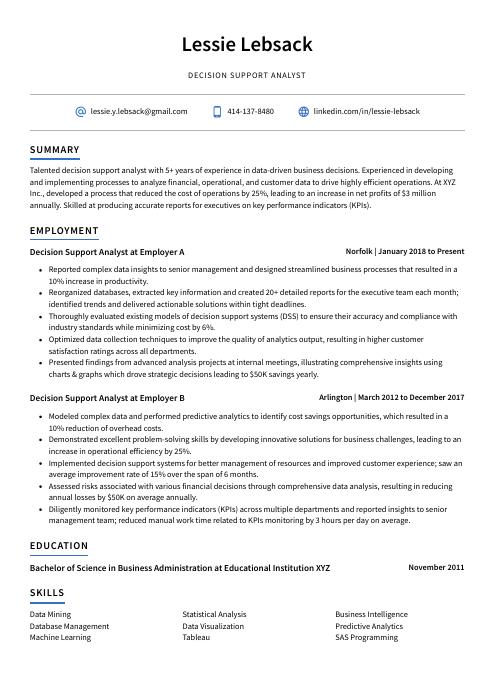 Axolotl
Axolotl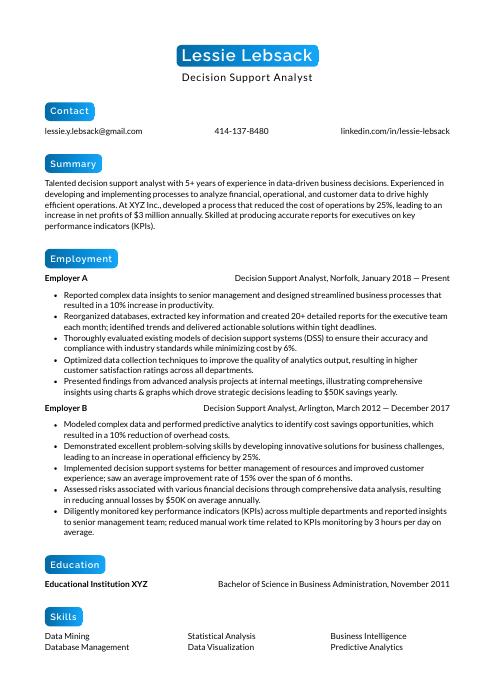 Kinkajou
Kinkajou Rezjumei
Rezjumei
